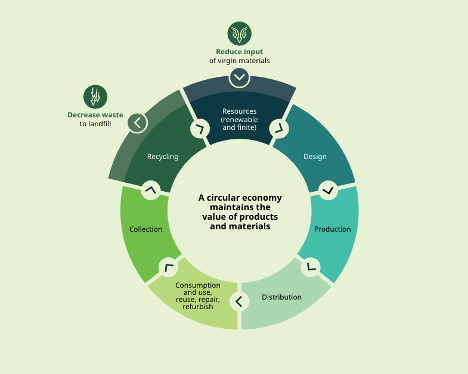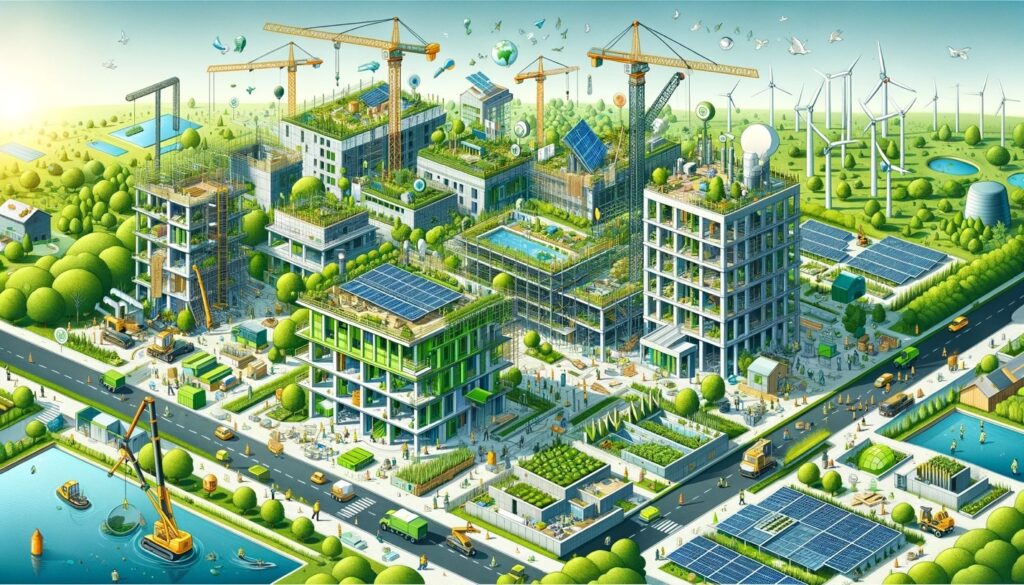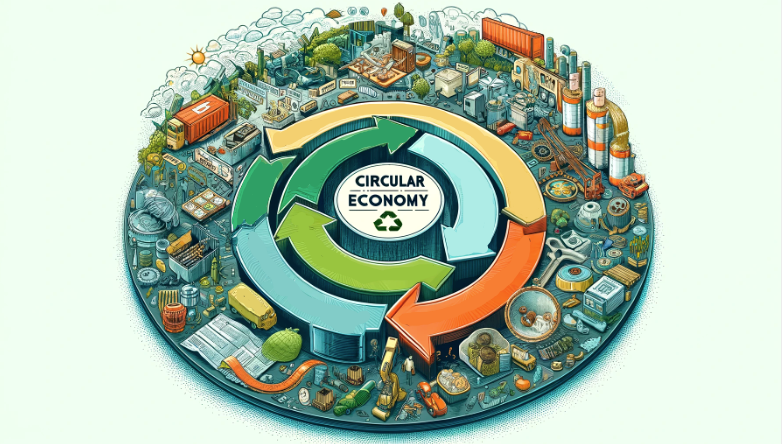The Australian Government is making strides towards sustainability with the upcoming Environmentally Sustainable Procurement (ESP) Policy, set to commence in July 2024.
This policy aims to integrate circular economy principles into procurement practices, promoting environmental responsibility and innovation across various sectors.
Here’s the low-down:
What it is:
The ESPP is a policy that aims to make the Australian Government’s spending more environmentally friendly. It comes into effect on July 1, 2024.
According to DCCEEW:
The policy applies environmentally sustainable principles to the following procurement categories:
- From 1 July 2024: construction services at or above $7.5 million:
- From 1 July 2025: furniture, fittings and equipment, ICT goods and textiles at or above $1 million.
Suppliers will need to show how they are complying with the policy.
See more here >
What it does:
The ESPP requires government officials to consider environmental factors when buying goods and services, particularly for high-value procurements (currently applies to construction services above $7.5 million). This means prioritizing things like:
- Minimising greenhouse gas emissions throughout the lifecycle of a product
- Using recycled materials
- Designing and buying products that last longer and can be repaired or reused.
Why This Matters to Australians & to Business
The Australian Government spends a significant amount of money each year, with expenditures reaching around $75 billion in 2022-23. By using its buying power to prioritise sustainable options, the Government can significantly reduce its environmental impact and encourage businesses to develop and offer more environmentally friendly products and services.
In a world where our choices echo in the environment, the impact of product manufacturing and consumption carries profound consequences. Nearly half of global greenhouse gas emissions stem from the creation and use of products, and more than 70% of a product’s environmental impact is determined at the design stage. This underscores the importance of getting things right from the start—designing products to be reused and recycled, not discarded.
The Australian Government takes its responsibility as environmental managers seriously. The introduction of the Environmentally Sustainable Procurement Policy (ESPP) is a testament to this commitment. Set to take effect in two stages from July 1, 2024, and July 1, 2025, the ESPP aims to drive a circular economy through the use of sustainable products. It promotes best practices in environmentally sustainable procurement across high-impact purchases such as construction services, ICT products, uniforms and textiles, and fit-outs of building and office interiors.
Sustainable procurement policies give businesses the confidence they need to make their products and services more sustainable, knowing there will be demand to sustain it. This policy sends a clear message that the Government is serious about fostering a circular economy and reducing environmental impacts. By leveraging its purchasing power, the Australian Government can encourage producers and manufacturers to innovate, creating products and services that quantify and reduce their environmental footprint.
Globally, public purchases are responsible for 15% of greenhouse gas emissions, highlighting the colossal scale of government spending on goods and services. Harnessing this financial might for positive environmental change is an opportunity and a responsibility. For instance, despite the high recyclability of office furniture, much of it still ends up in landfills. The Government’s purchasing decisions can help change this by setting standards and creating markets for recycled and sustainable goods.
Transitioning to a Circular Economy

The way government procures goods and services is shifting towards circular economy principles. Keeping resources in the value chain for longer ensures a more sustainable footing for economic growth. The policy sends a clear message to drive a circular economy through sustainable products, promoting best practices across high-impact purchases such as construction services, ICT products, uniforms and textiles, and building and office fit-outs.
A circular economy opposes a linear ‘throwaway’ society model. Instead of depleting resources, it focuses on reusing and transforming materials. This approach aims to change patterns of natural resource use, promoting sustainable growth by maintaining the value of resources for as long as possible. In a circular economy, buildings and fit-outs use fewer materials, minimise waste, and are designed for adaptability. Goods are durable, repairable, reusable, and recyclable, often containing recycled content and being returned for resource recovery at the end of their life cycle. Traditional procurement processes are modernising to optimise the use of limited resources and minimise environmental impact. This shift supports sustainable practices, ensuring that nothing is wasted and everything is reused or transformed.
What the ESPP Means for Your Construction Business

As a construction business, the Environmentally Sustainable Procurement Policy (ESPP) has significant implications for your operations, procurement processes, and overall business strategy.
The policy currently applies to government construction services exceeding $7.5 million in value.
If you tender for smaller projects, it likely won’t affect you directly. You must demonstrate how you’ll achieve agreed-upon sustainability goals for applicable projects. This might involve minimising construction waste or using recycled building materials wherever possible. The policy aims to promote a circular economy in construction, which means reusing and repurposing materials instead of relying solely on virgin resources. You should explore using recycled steel, timber, or concrete on projects.
The Government will likely outline reporting requirements to track your environmental performance on these projects, so be prepared to document your efforts towards sustainability goals. While adjustments must be made, the ESPP can also be an opportunity. By embracing sustainable practices, you can become more competitive in bidding for government projects, align yourself with the growing focus on environmental responsibility in the construction industry, and potentially reduce waste disposal costs and optimise resource use.
Here’s what you need to know and how you can prepare:
Supplier Environmental Sustainability Plan (SESP) in Australia’s ESP Policy
The Supplier Environmental Sustainability Plan (SESP) is a key element of the Environmentally Sustainable Procurement Policy (ESP) implemented by the Australian government. The SESP serves as a tool for construction suppliers to demonstrate their commitment to environmentally sustainable practices during the bidding process for government construction projects exceeding $7.5 million.
Two Options for Buyers:
- Option A – Applying a Sustainability Rating: The buyer can choose a specific sustainability rating system (like Infrastructure Sustainability (IS rating scheme) to evaluate tenders. In this case, your SESP would need to address how you’d meet the criteria of that rating system.
- Option B – Reporting Against Base Metrics: The buyer might outline a set of base environmental metrics they prioritise (e.g., waste reduction, recycled material usage). Your SESP would then detail your plans for achieving those specific goals.
Components of a SESP:
The SESP typically consists of two parts:
1. The Plan: This outlines your company’s approach to environmental sustainability in construction projects. It should address areas like:
- Construction Waste Management: Plans to minimise waste generation and maximise recycling during construction.
- Sustainable Materials: Strategies for incorporating recycled or environmentally friendly materials into the project.
- Energy and Water Efficiency: Measures to reduce energy and water consumption throughout the project lifecycle.
- Environmental Impact Mitigation: Strategies to minimise negative environmental impacts like dust, noise, or pollution during construction.
2. Reporting Template: This section allows you to report on your environmental performance against the chosen metrics (either from the sustainability rating or the buyer’s base metrics).
Benefits for Businesses:
- Demonstrating solid environmental practices through a well-developed SESP can make your bid more competitive when applying for government construction projects.
- The ESP’s focus on a circular economy can encourage innovation in using recycled materials, potentially reducing costs and environmental impact.
Keep an eye on their website https://www.dcceew.gov.au/ for updates on SESP guidelines and templates.
Remember: While specifics might vary depending on the buyer’s chosen approach (rating system or base metrics), a well-crafted SESP showcasing your commitment to sustainable construction can be a valuable asset in securing government contracts
Need Your Procurement Practices Assessed?
As sustainability becomes key in procurement, our tool reviews your capabilities, focusing on sustainability and ethical sourcing.
Why It Matters:
With the ESP Policy transforming procurement, our assessment aligns your practices with these new standards. We analyse your current state and guide you to higher maturity levels on Sustainability and Ethical Sourcing. We will rate your practices from basic to best in class, so you know where you stand and what to remedy.
How It Works:
Our diagnostic benchmarks your procurement maturity, identifying growth areas and setting attainable goals. This strategic insight aids in decision-making for procurement strategies and skill development.

Eco-Friendly Procurement: Seven Tips for Immediate Impact
1. Conduct Comprehensive Supplier Analysis:
Evaluate your current suppliers to identify those already aligning with environmental sustainability practices. This assessment should include examining their use of recycled materials, waste management strategies, and overall environmental impact. Developing criteria for assessing potential new suppliers based on these sustainability credentials will help ensure future procurement decisions support the ESP policy.
In this analysis, consider using tools like supplier scorecards or sustainability performance ratings to quantify and compare the environmental efforts of different suppliers. This will enable a more structured and objective approach to selecting suppliers who can help achieve your sustainability goals.
See Purchasing Index for Spend Analytics Featuring Supplier Sustainability Dashboards
2.Enhance Supplier Relationship Management (SRM):
Foster closer relationships with key suppliers to ensure they understand the new sustainability requirements and are motivated to meet them. Regular communication and collaboration with suppliers can help develop and implement sustainability improvement plans, ensuring a shared commitment to minimising environmental impactsFoster closer relationships with key suppliers to ensure they understand the new sustainability requirements and are motivated to meet them. Regular communication and collaboration with suppliers can help develop and implement sustainability improvement plans, ensuring a shared commitment to minimising environmental impacts.
By involving suppliers in sustainability initiatives, you can work together to find innovative solutions for reducing waste and improving the use of recycled materials. Building strong, cooperative relationships with suppliers can lead to better compliance and more effective implementation of sustainable practices.

3. Implement Rigorous Supplier Audits:
Conduct regular audits of your suppliers to verify their compliance with the ESP policy. These audits should focus on critical sustainability metrics, such as greenhouse gas emissions, waste management practices, and the use of recycled materials. By monitoring suppliers’ adherence to these standards, you can ensure ongoing compliance and identify areas for improvement.
Supplier audits not only ensure compliance but also provide valuable insights into the effectiveness of current sustainability practices. Use the audit results to guide suppliers in making necessary adjustments and improvements, fostering a continuous improvement culture.
4. Develop a Supplier Environmental Sustainability Plan (SESP):
Work with your suppliers to create an SESP that outlines their approach to sustainability in alignment with the ESP policy. This plan should include specific targets for waste reduction, the use of sustainable materials, and energy efficiency. By having a clear, documented plan, both parties can align their efforts and track progress towards sustainability goals.
The SESP should be a living document, regularly reviewed and updated to reflect new sustainability challenges and opportunities. Encourage suppliers to set ambitious yet achievable targets and support them with the necessary resources and guidance to meet these goals.
5. Incorporate Circular Economy Principles in Contracts:
Update procurement contracts to include clauses that mandate the use of sustainable practices and materials. Specify requirements for products to be durable, repairable, and recyclable, ensuring that suppliers commit to these principles. Additionally, require suppliers to report on their environmental performance, providing transparency and accountability.
Contracts should clearly define the expectations for sustainability and outline the consequences of non-compliance. This approach not only enforces sustainable practices but also incentivises suppliers to innovate and find more environmentally friendly solutions.
6. Train and Educate Procurement Teams:
Provide training for your procurement team on the new ESP policy and the importance of sustainability in procurement. Equip your team with the knowledge and skills needed to evaluate and select suppliers based on their environmental performance. Regular workshops and training sessions can keep the team updated on the latest sustainability trends and best practices.
By fostering a culture of sustainability within your procurement team, you can ensure that environmental considerations are integrated into every purchasing decision. This proactive approach will help your organisation stay ahead of regulatory requirements and industry standards.
See Academy of Procurement for Specialised Training
7. Monitor and Report Sustainability Performance:
Establish a robust system for tracking and reporting on sustainability metrics related to your procurement activities. This system should capture data on key performance indicators such as waste reduction, recycled material usage, and greenhouse gas emissions. Use these reports to review progress, identify areas for improvement, and make necessary adjustments.
Regularly sharing sustainability performance reports with stakeholders, including suppliers and internal teams, promotes transparency and accountability. It also provides an opportunity to celebrate successes and learn from challenges, driving continuous improvement in your sustainability efforts.
In Conclusion
The Environmentally Sustainable Procurement Policy (ESPP) marks a significant shift in how the Australian Government approaches procurement, emphasizing sustainability and circular economy principles. By adopting these practices, businesses can gain a competitive edge, reduce their environmental impact, and align with future regulatory standards.
Part 2 will dive deeper into the specific insights and perspectives from industry experts on the ESPP. Stay tuned to learn more about how this policy is expected to shape various sectors and how you can prepare your business to thrive under these new guidelines.



